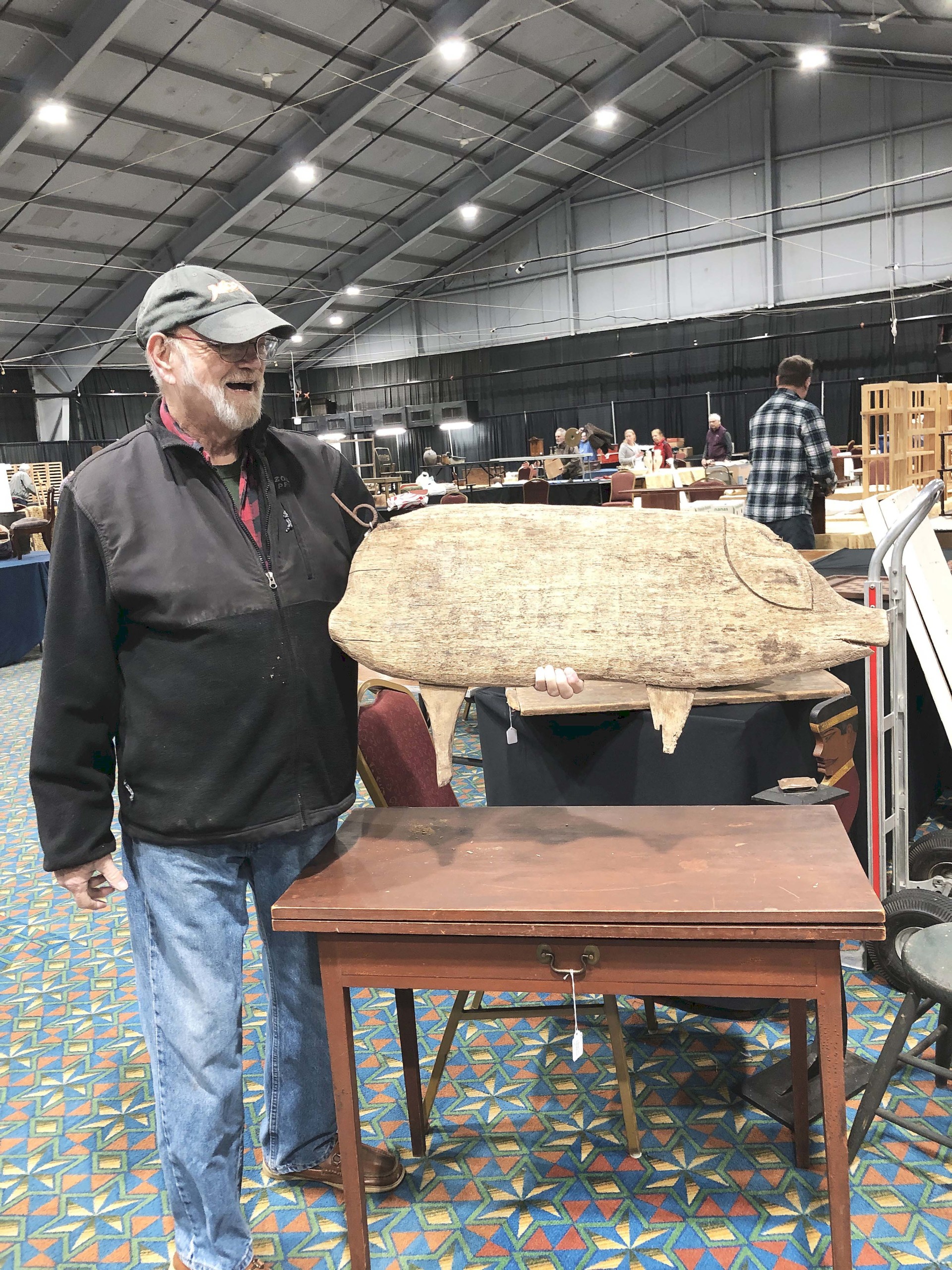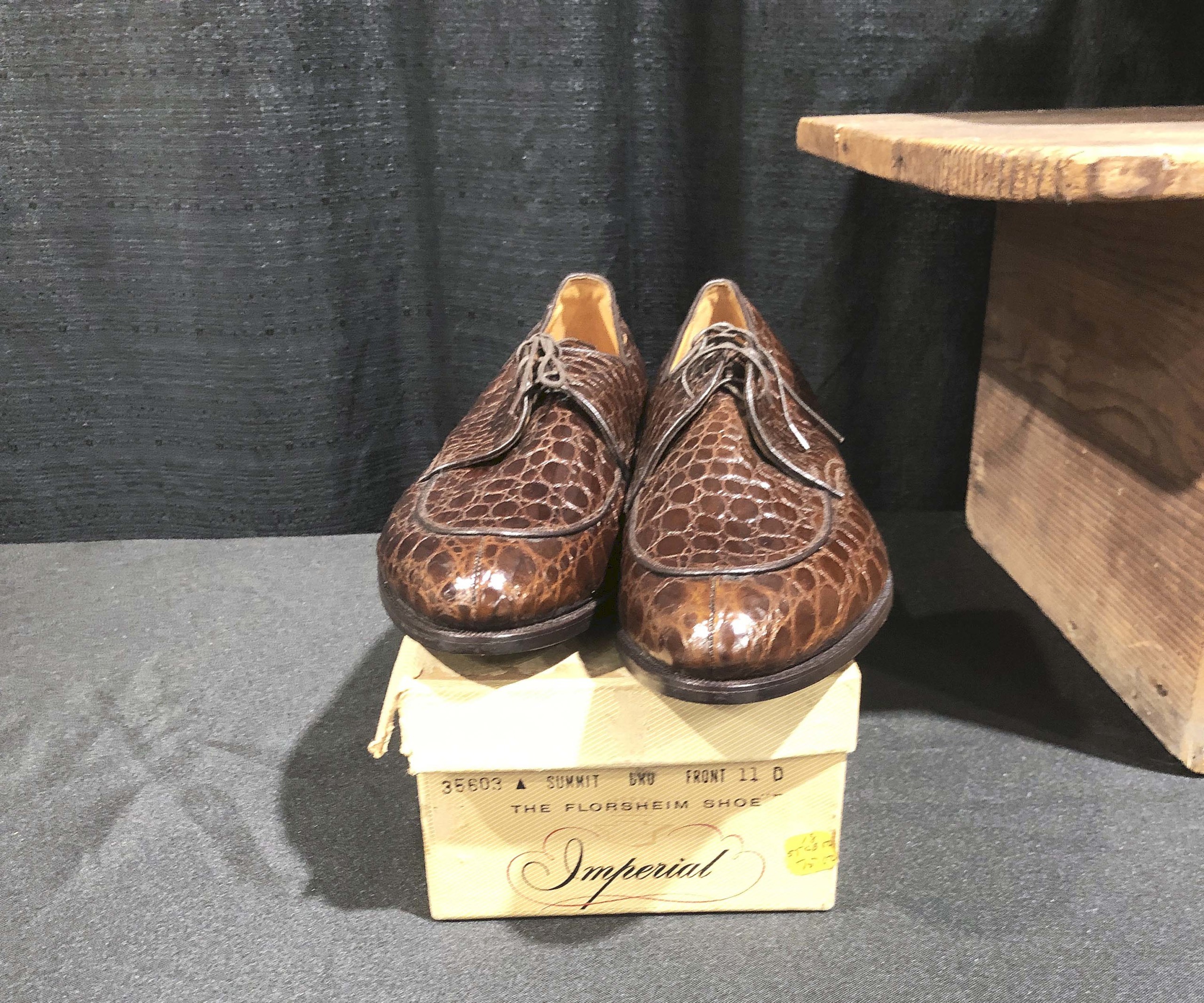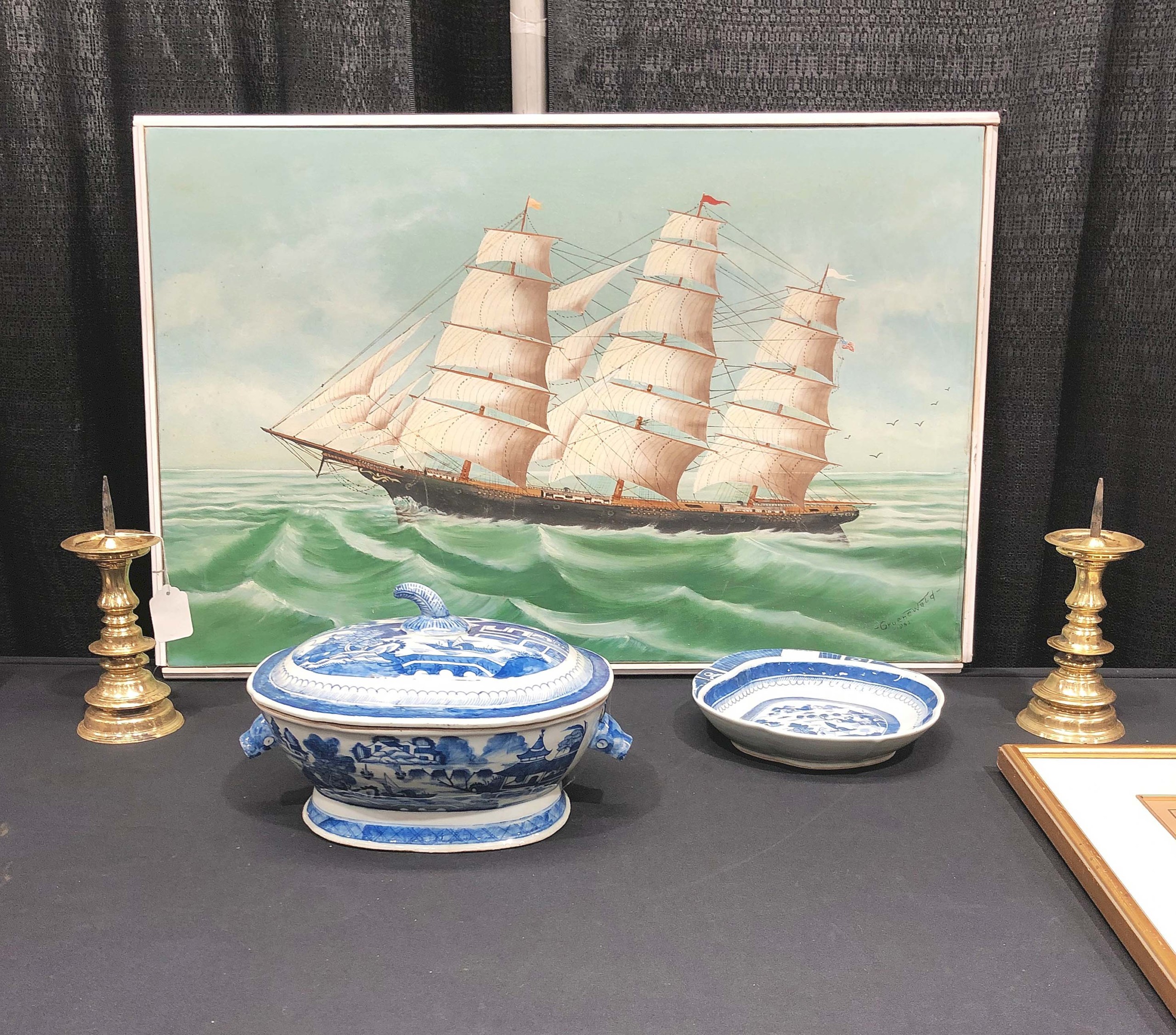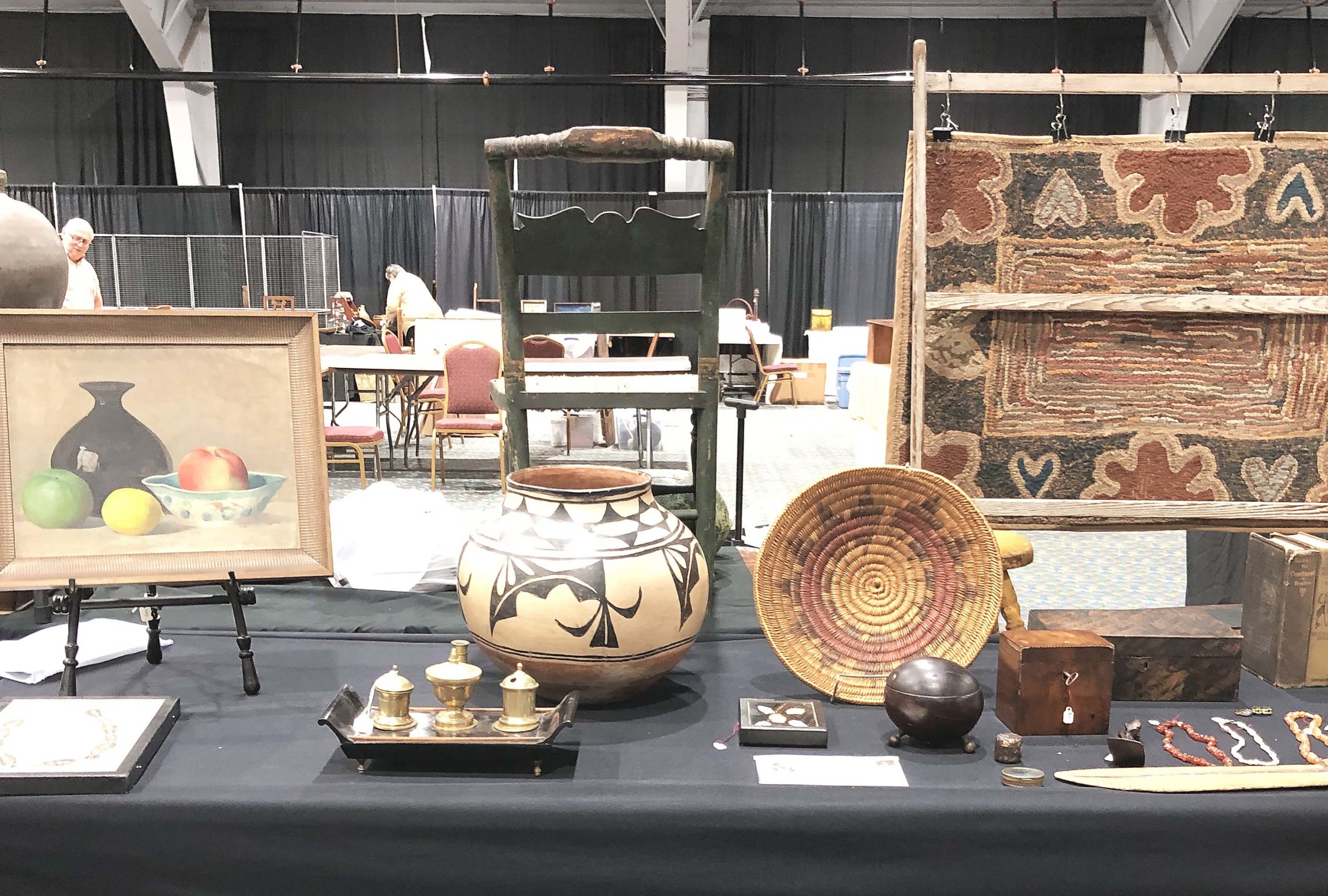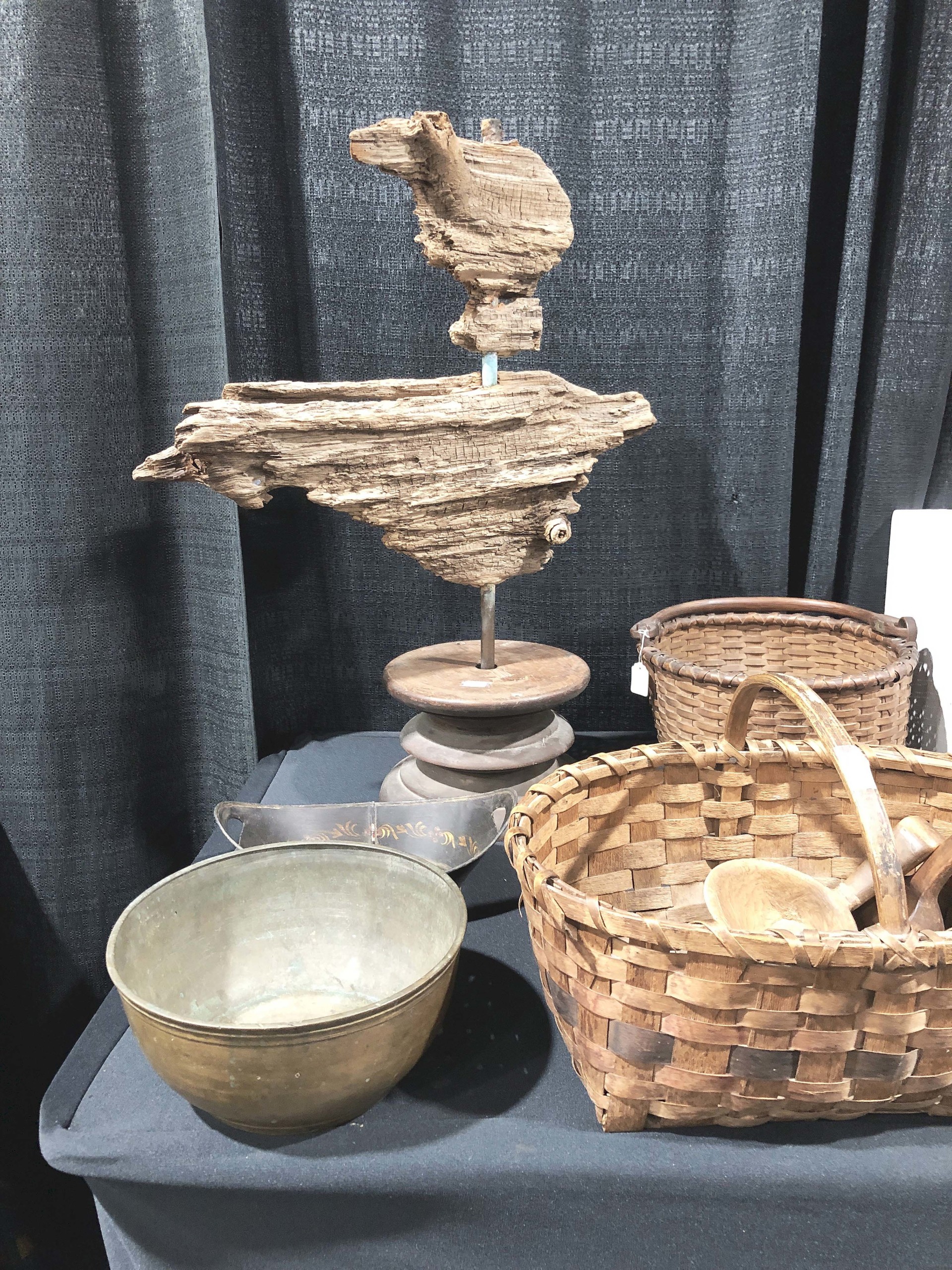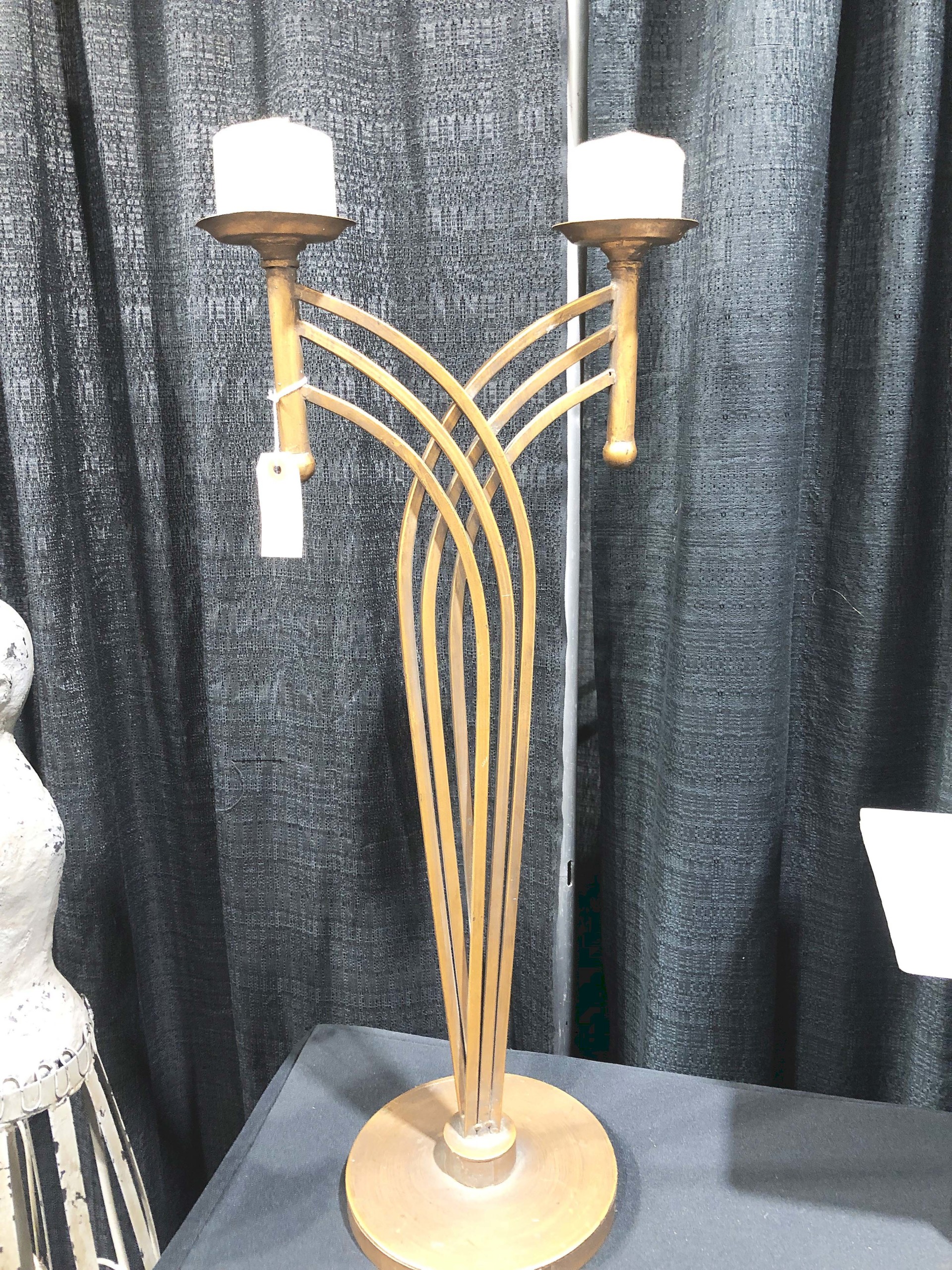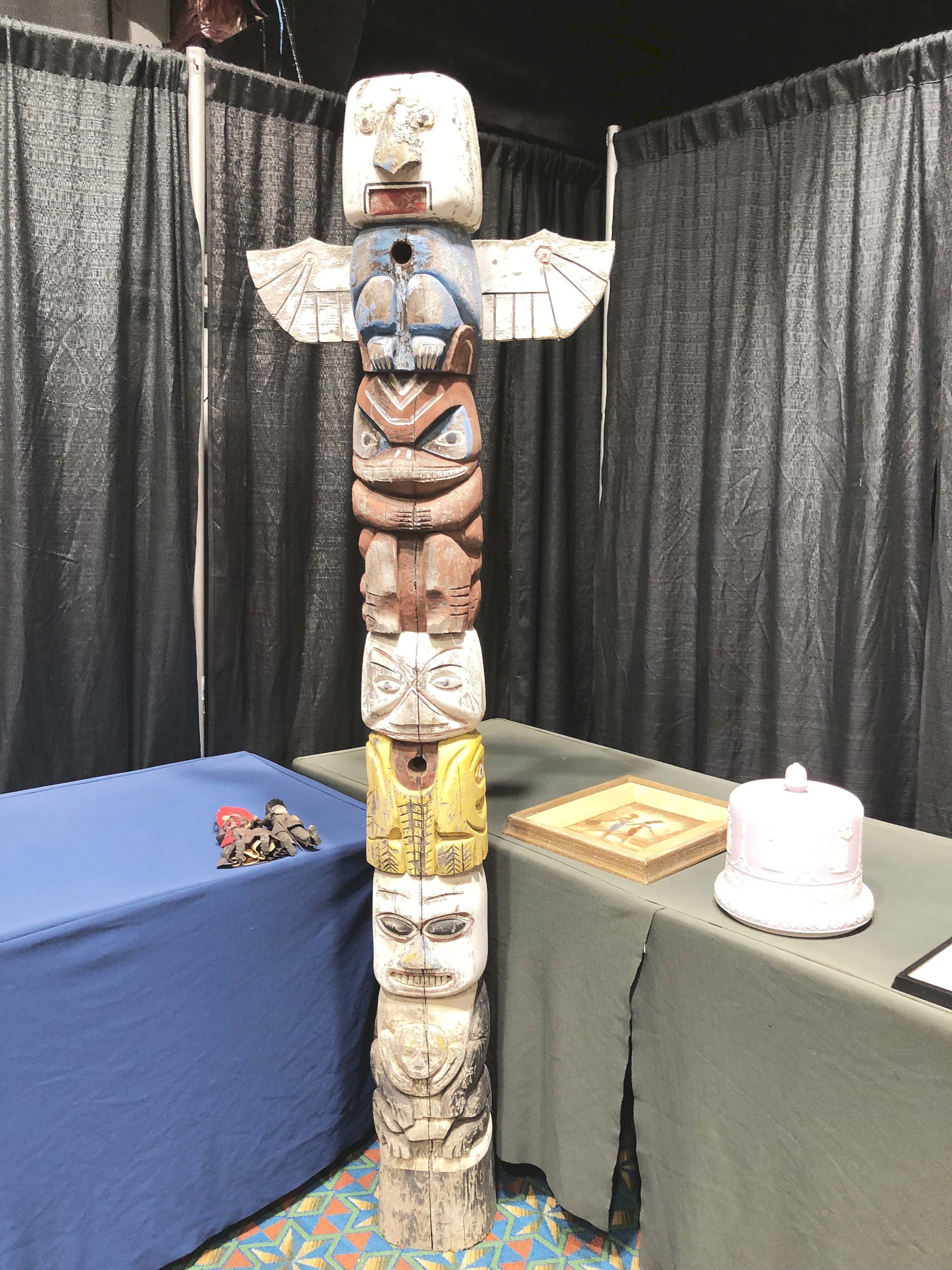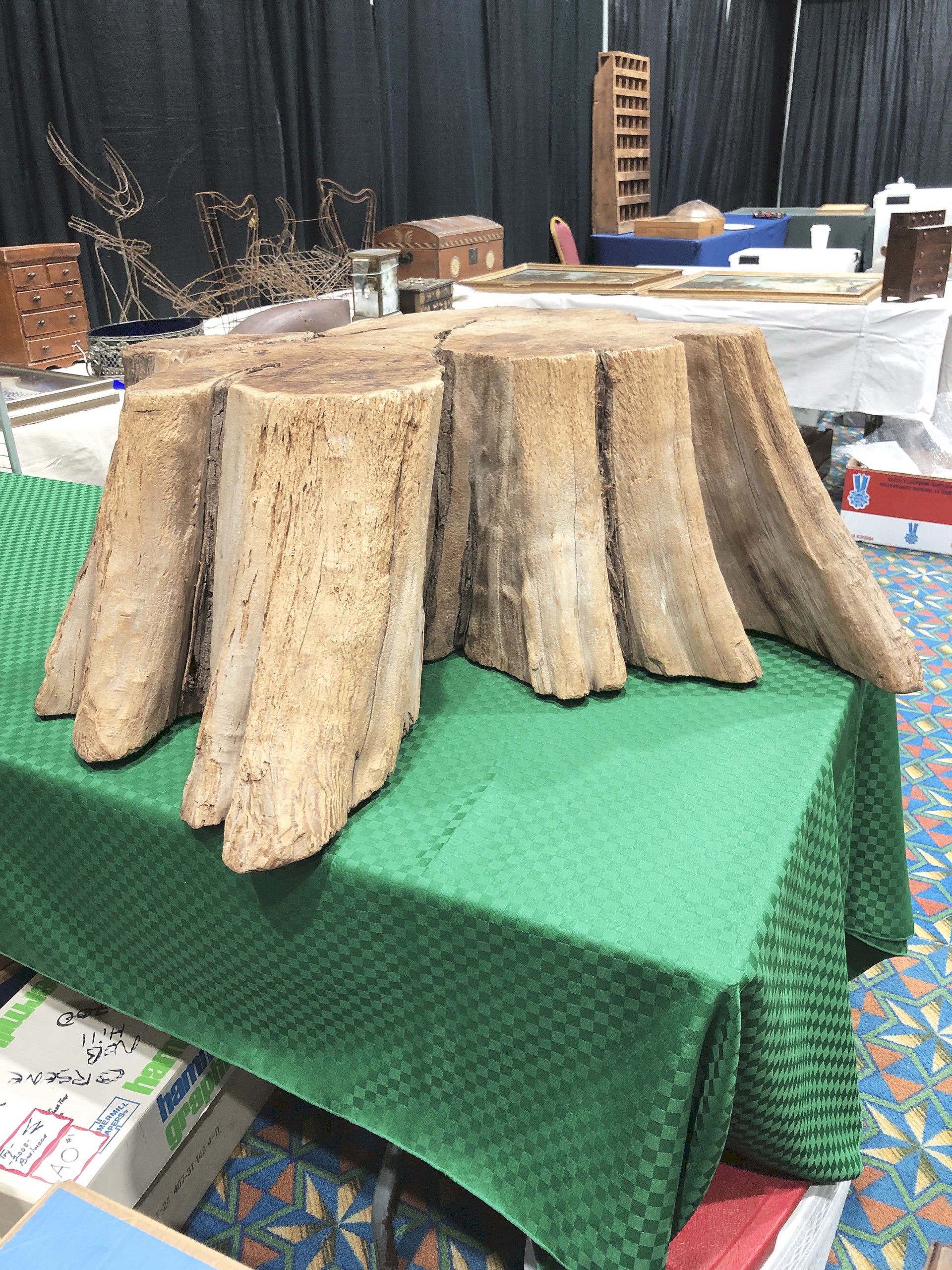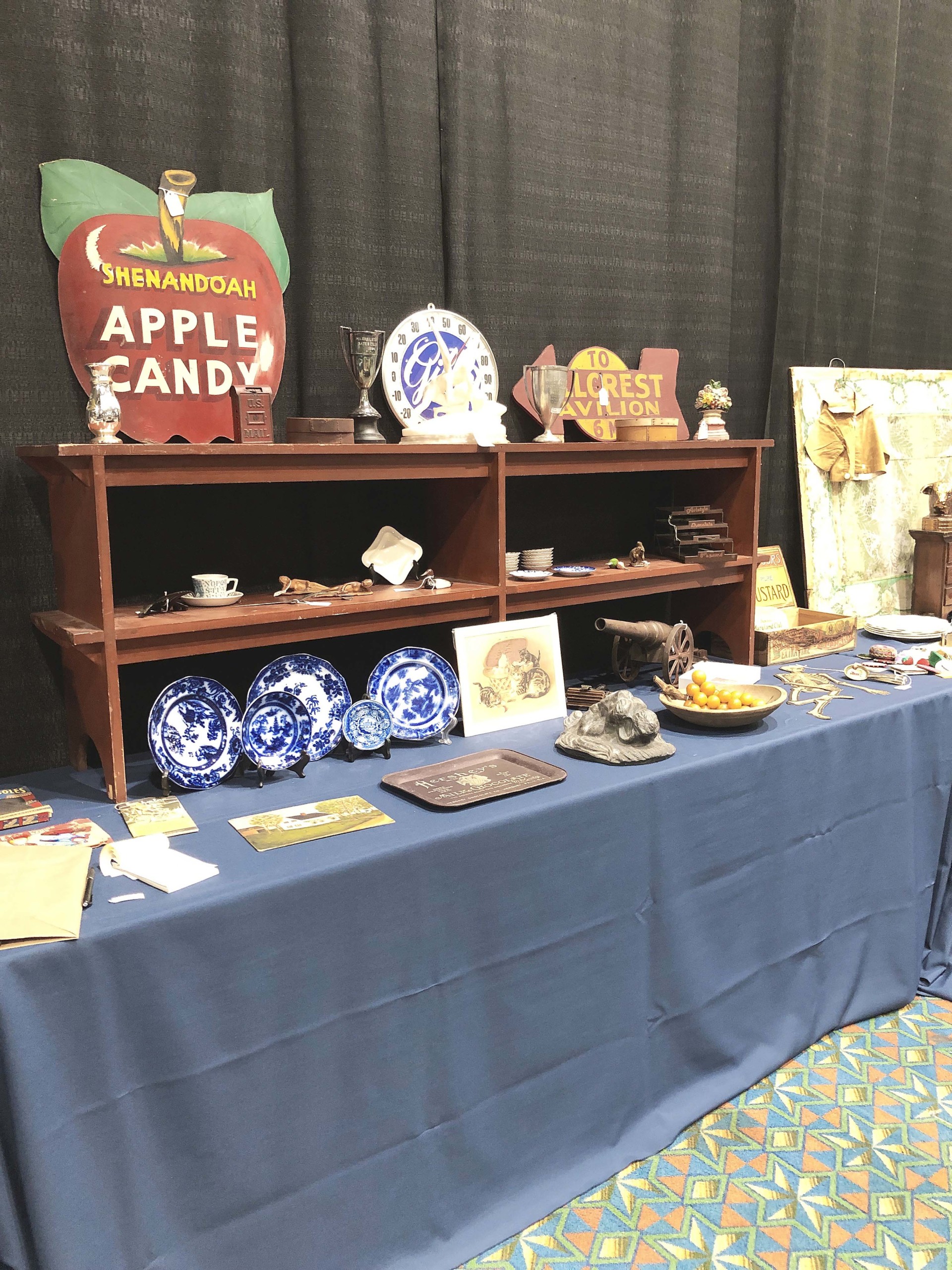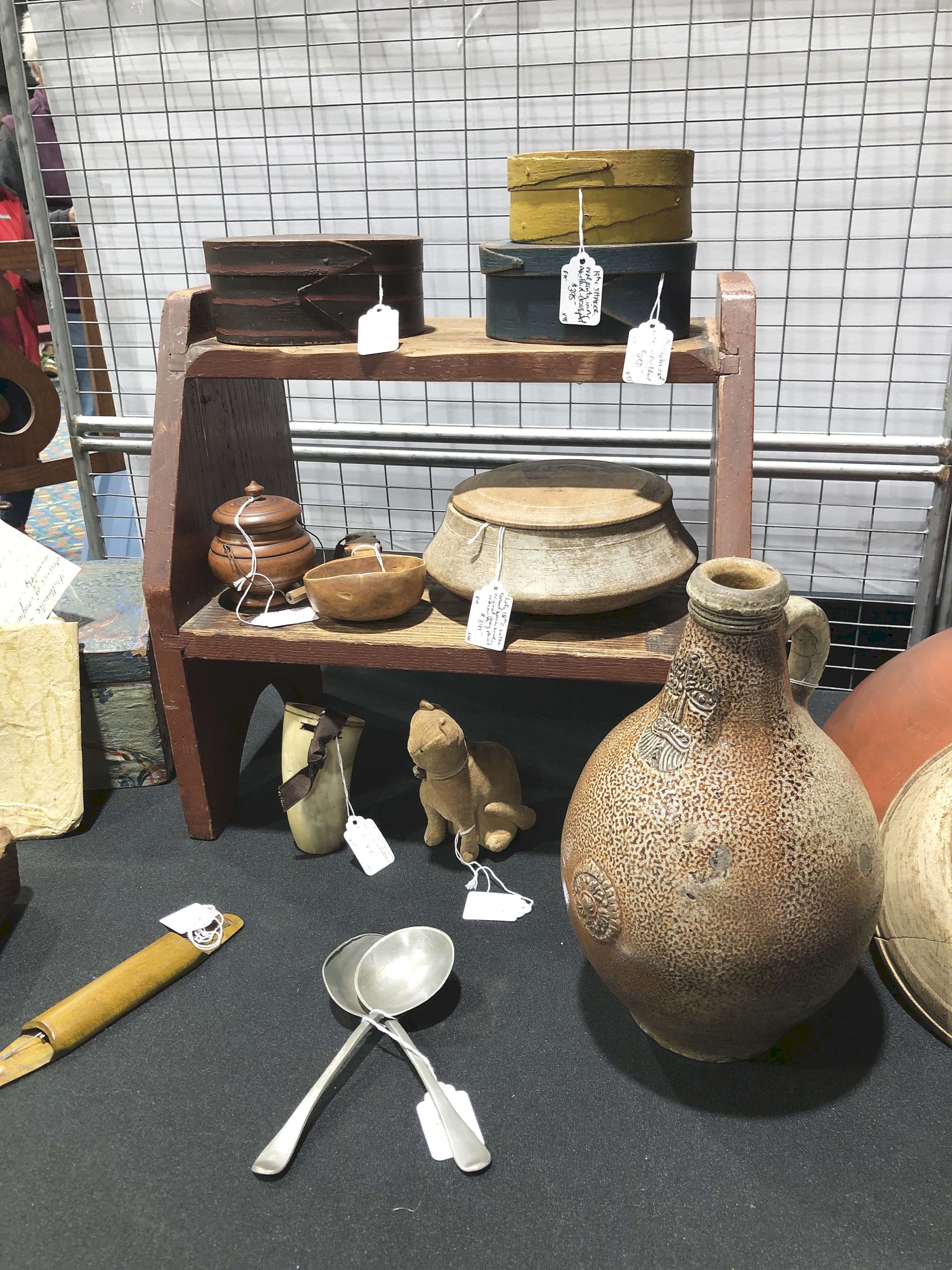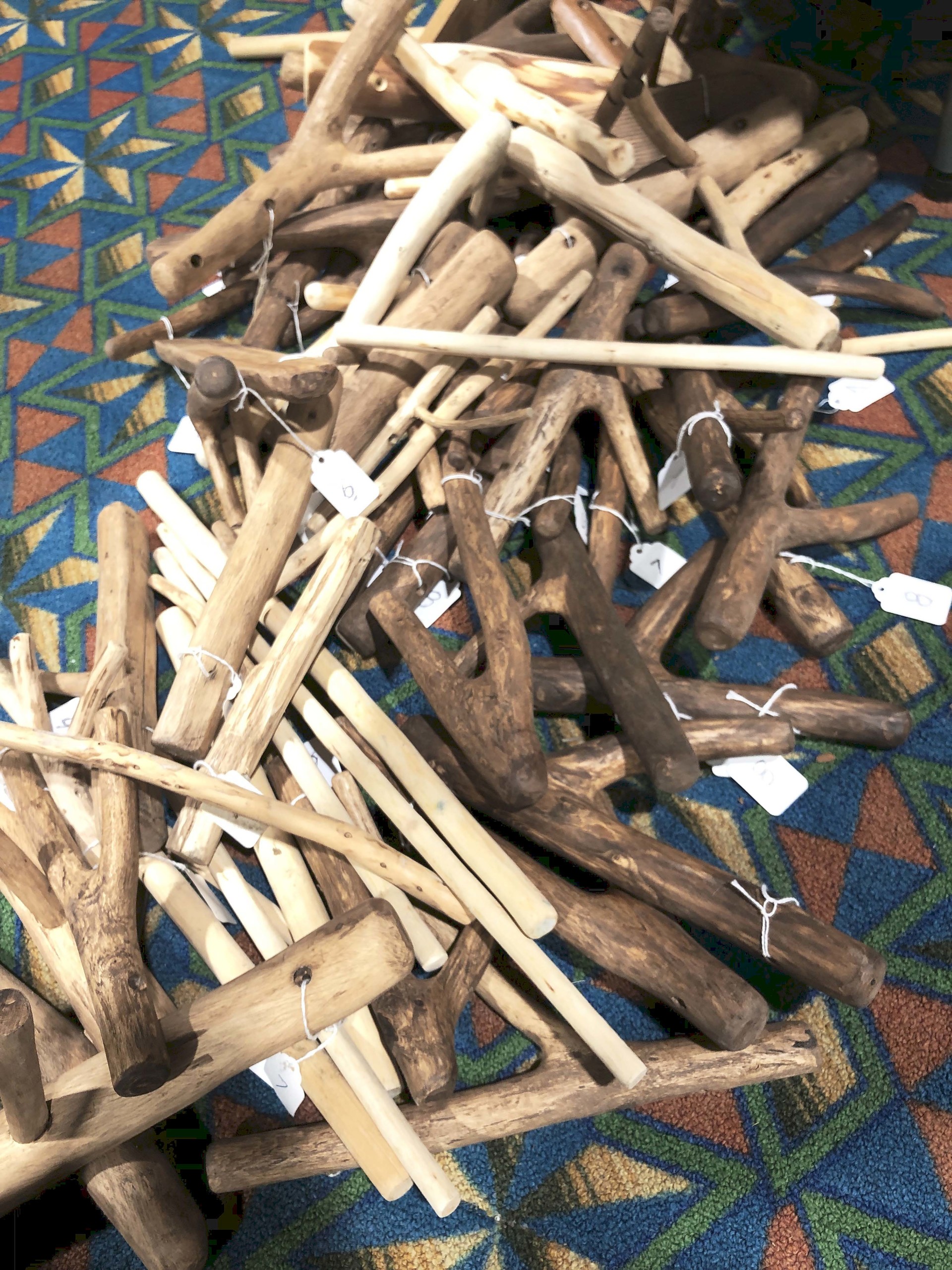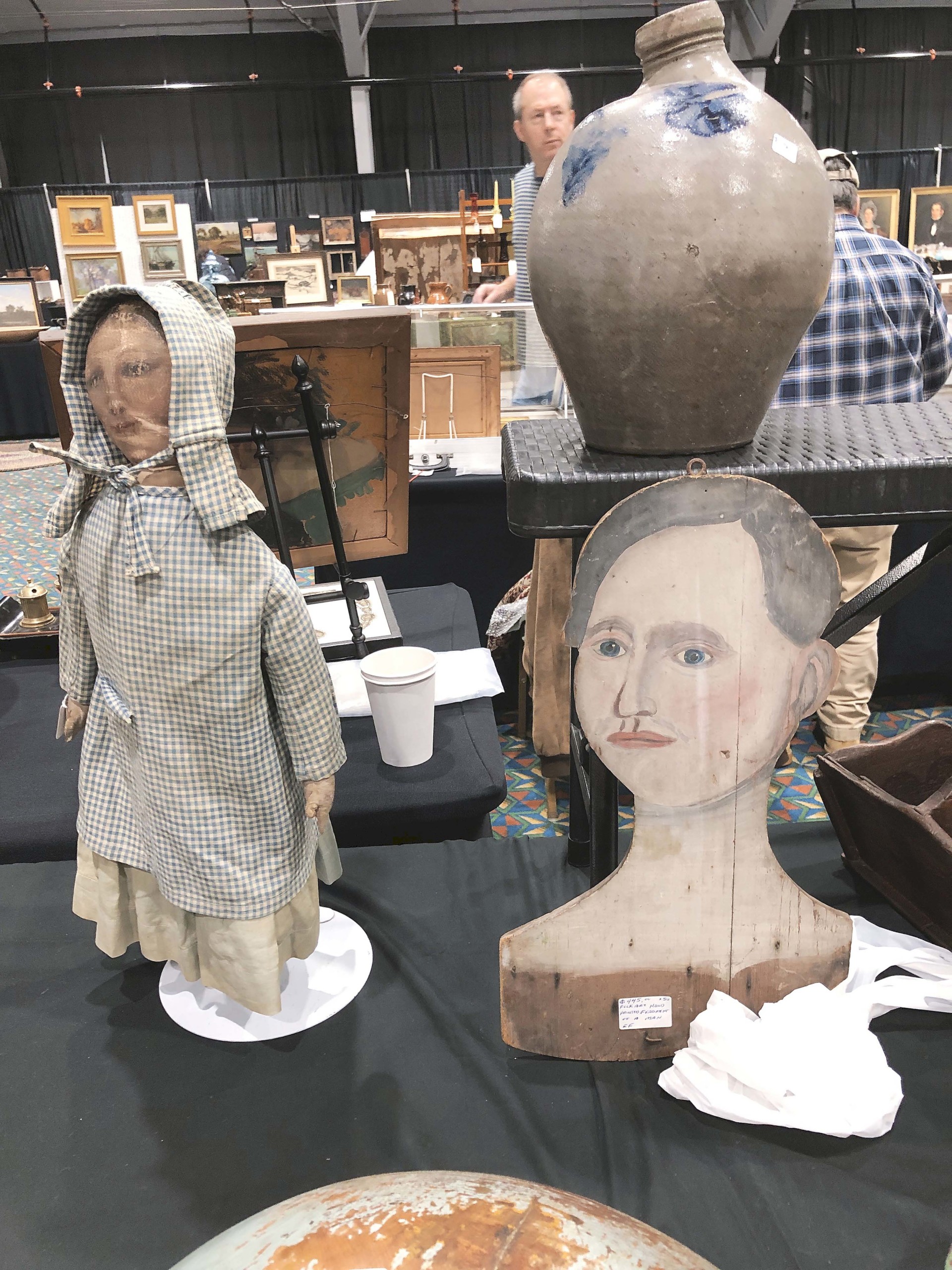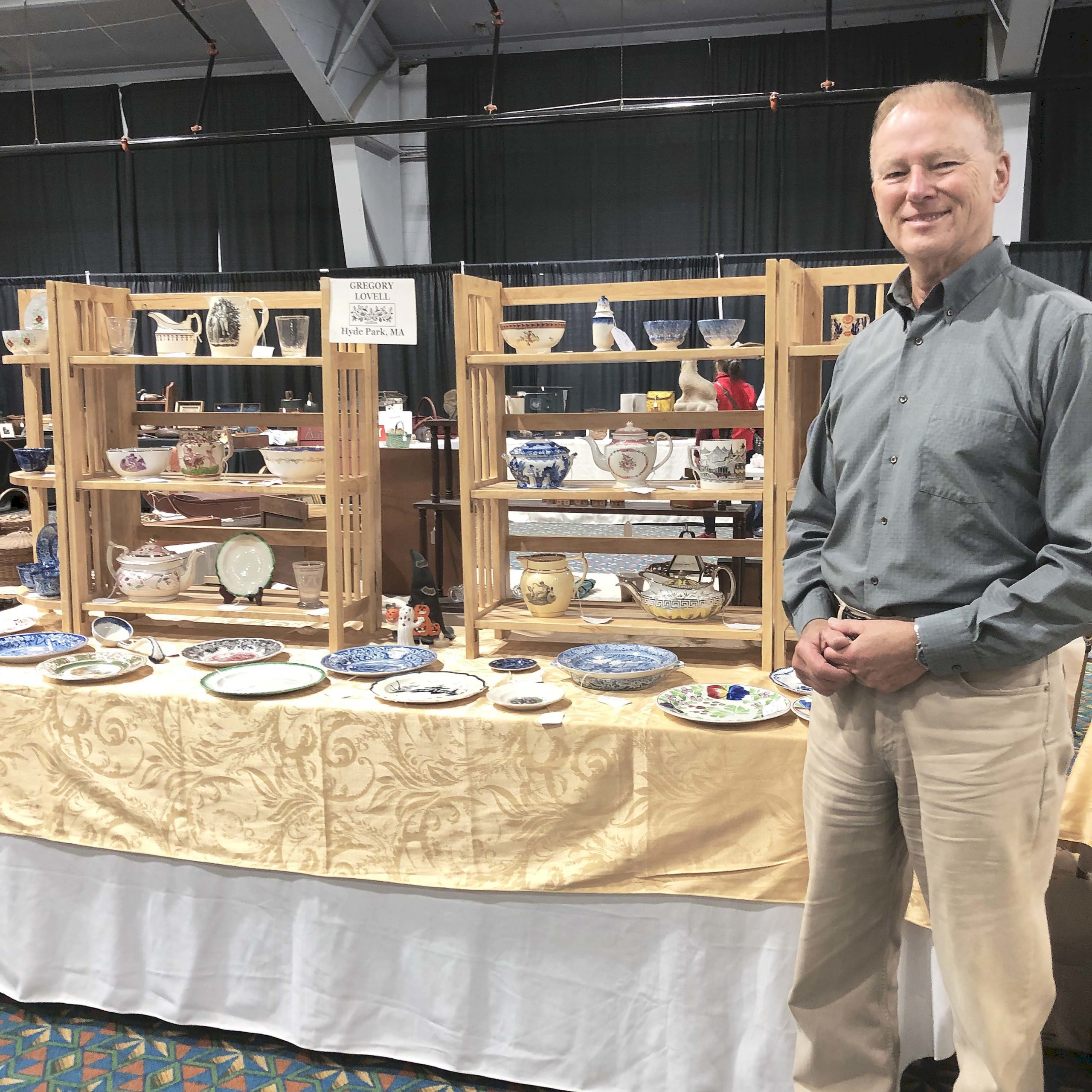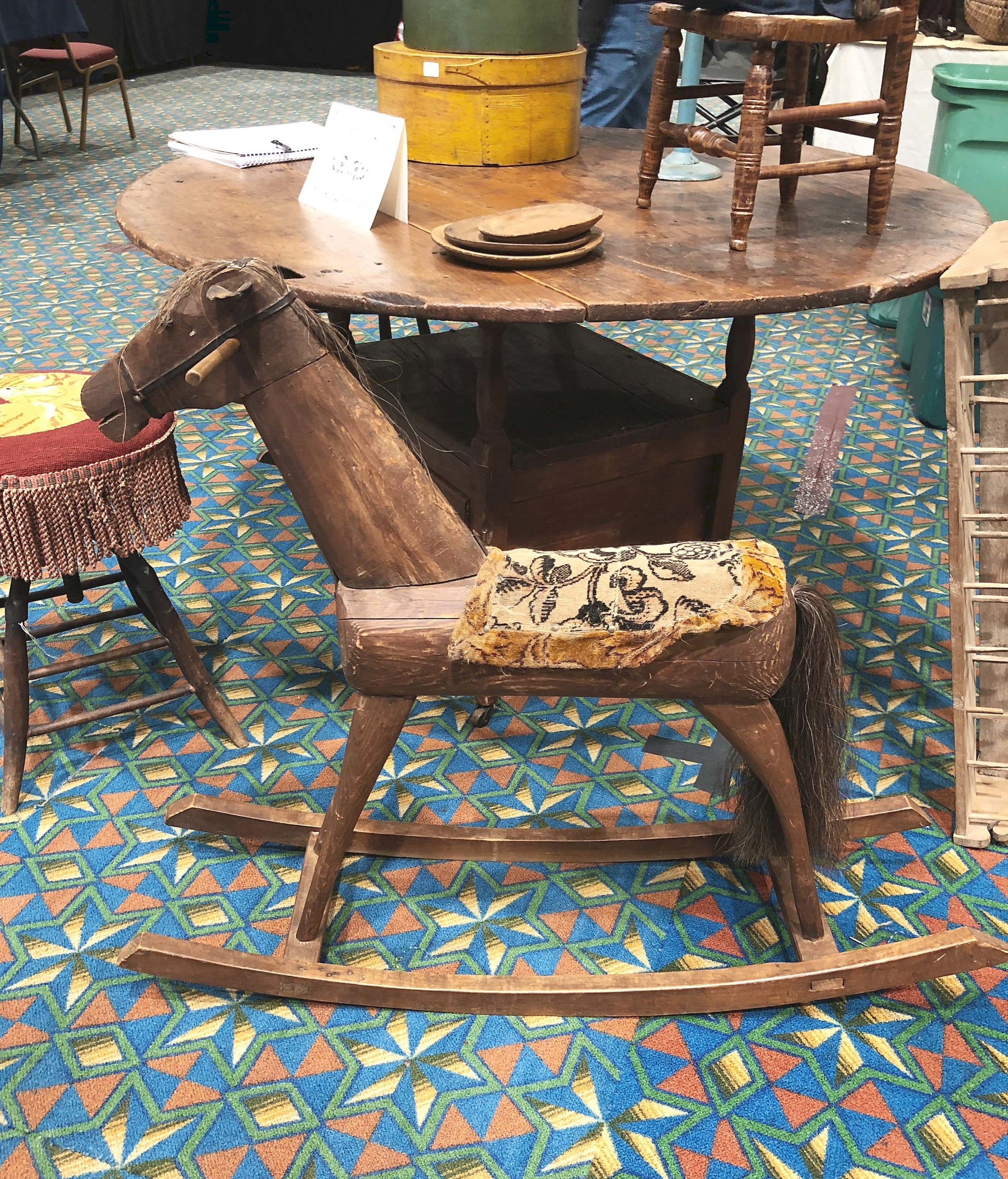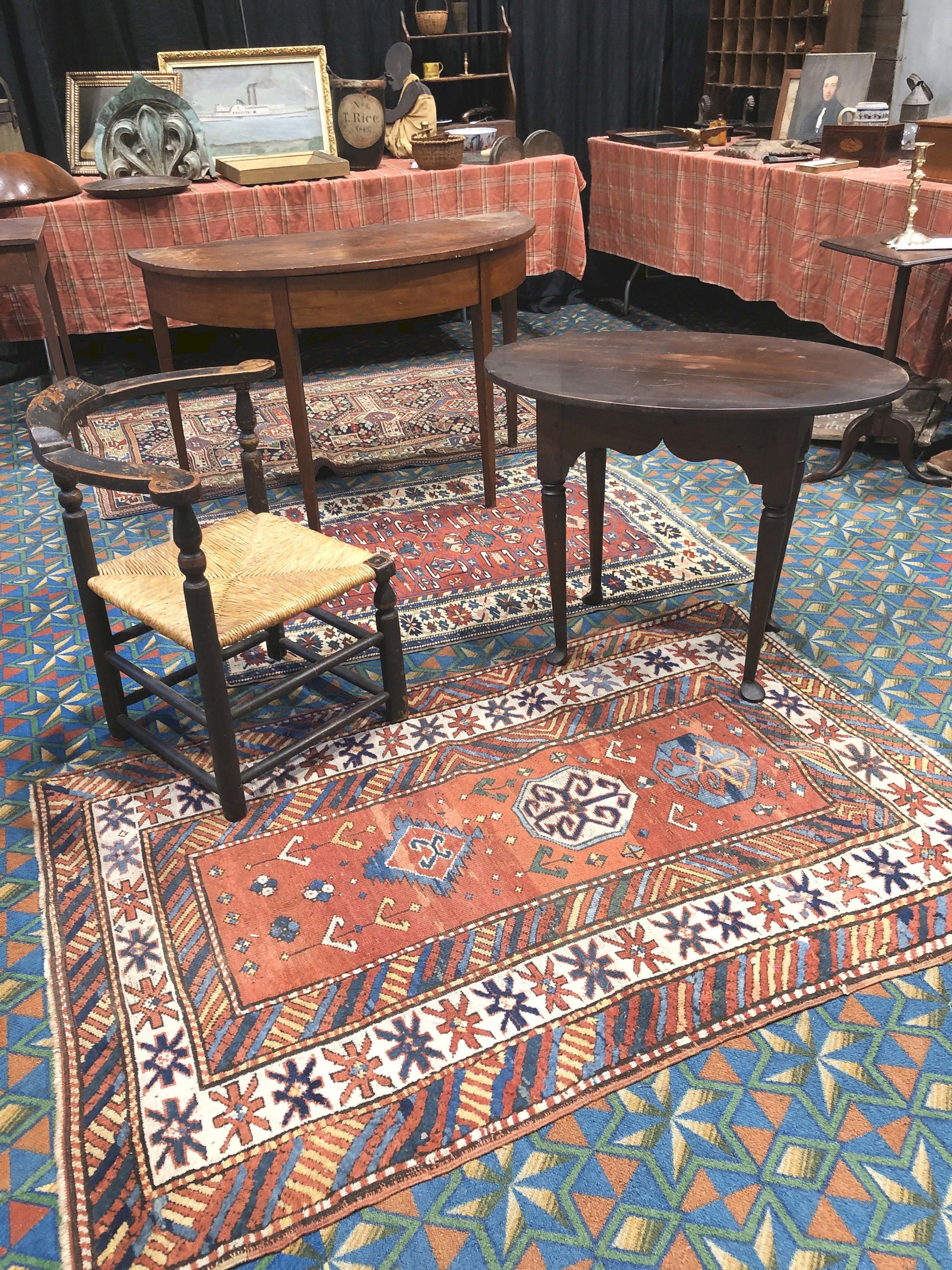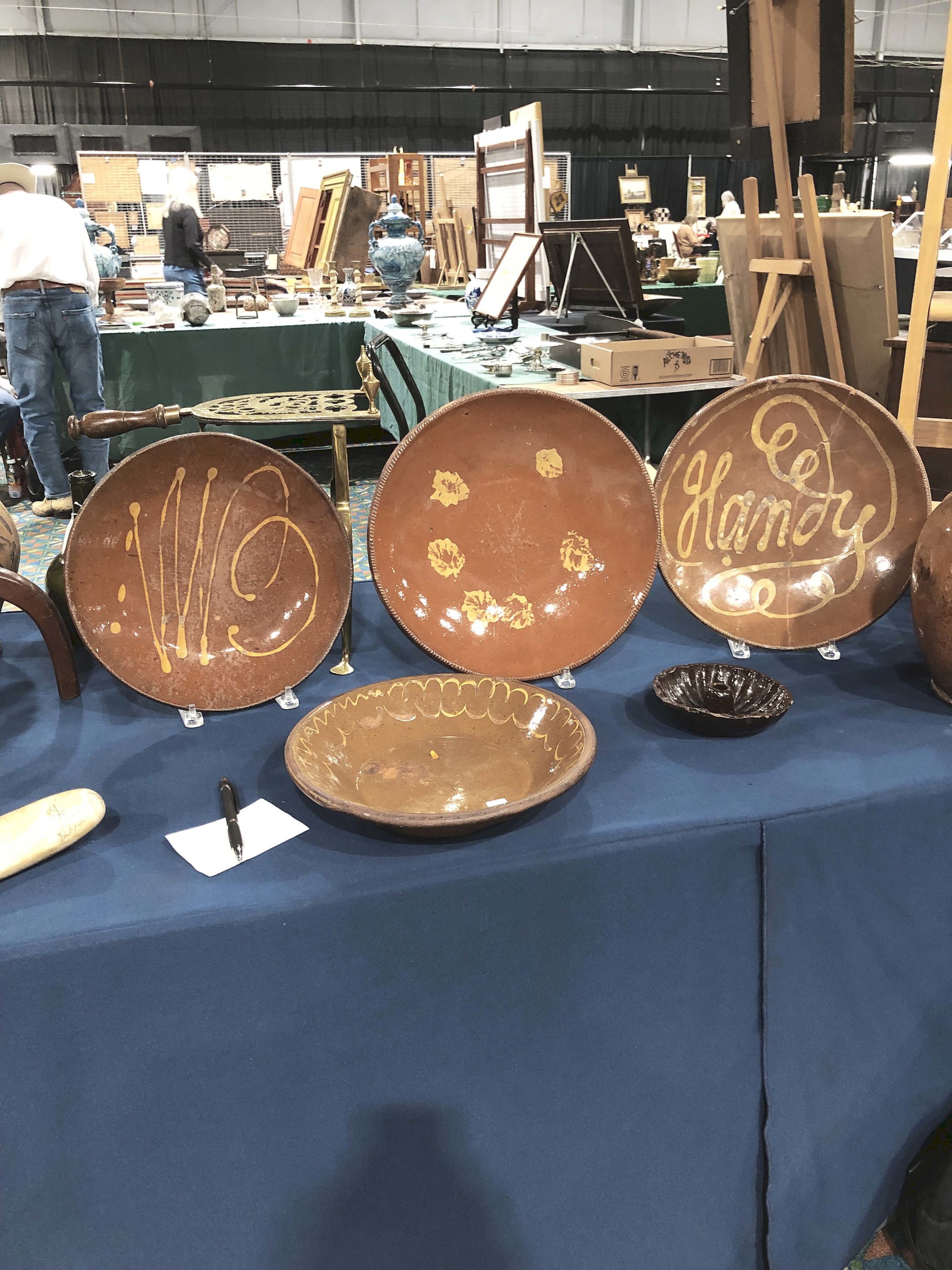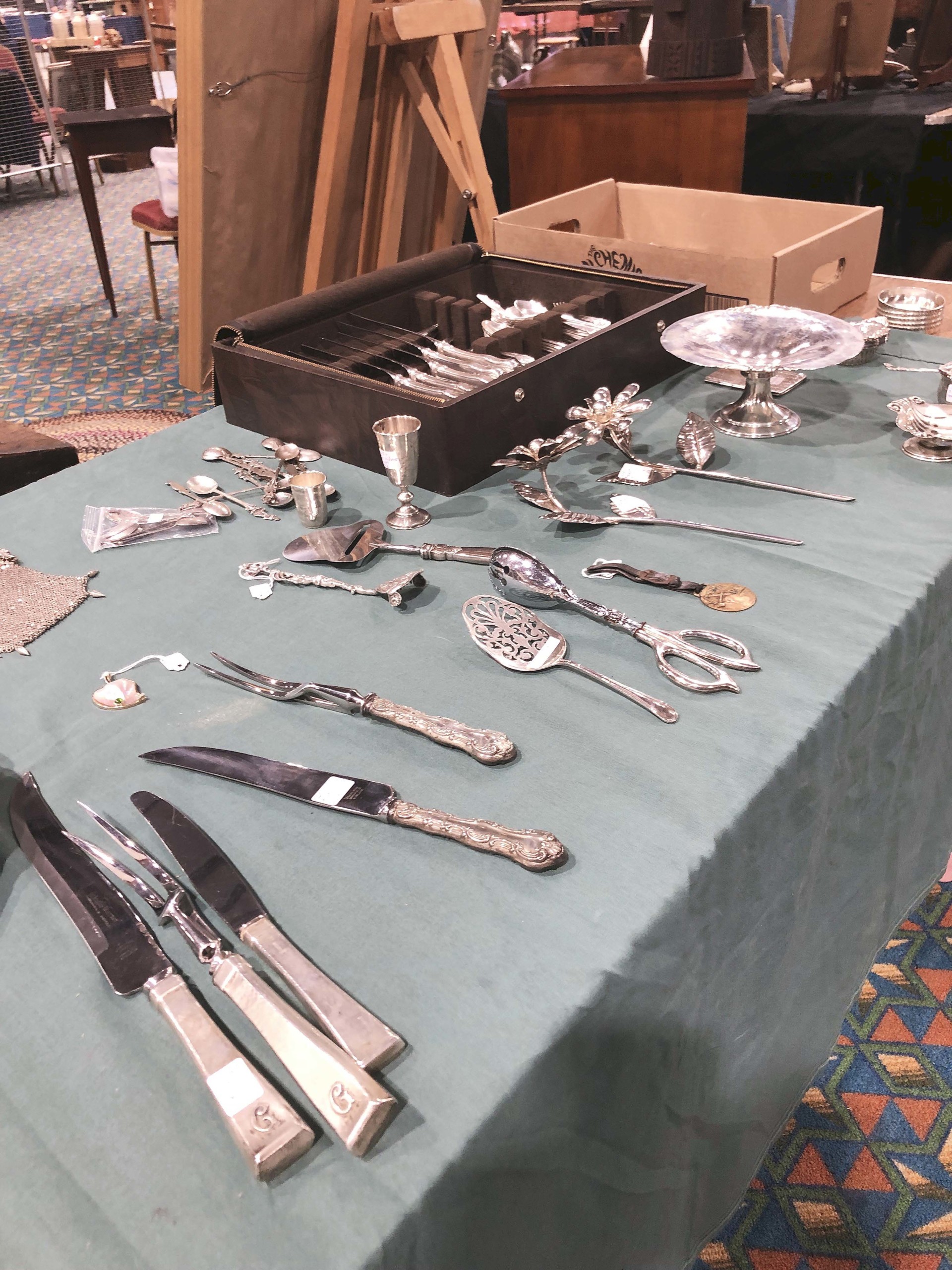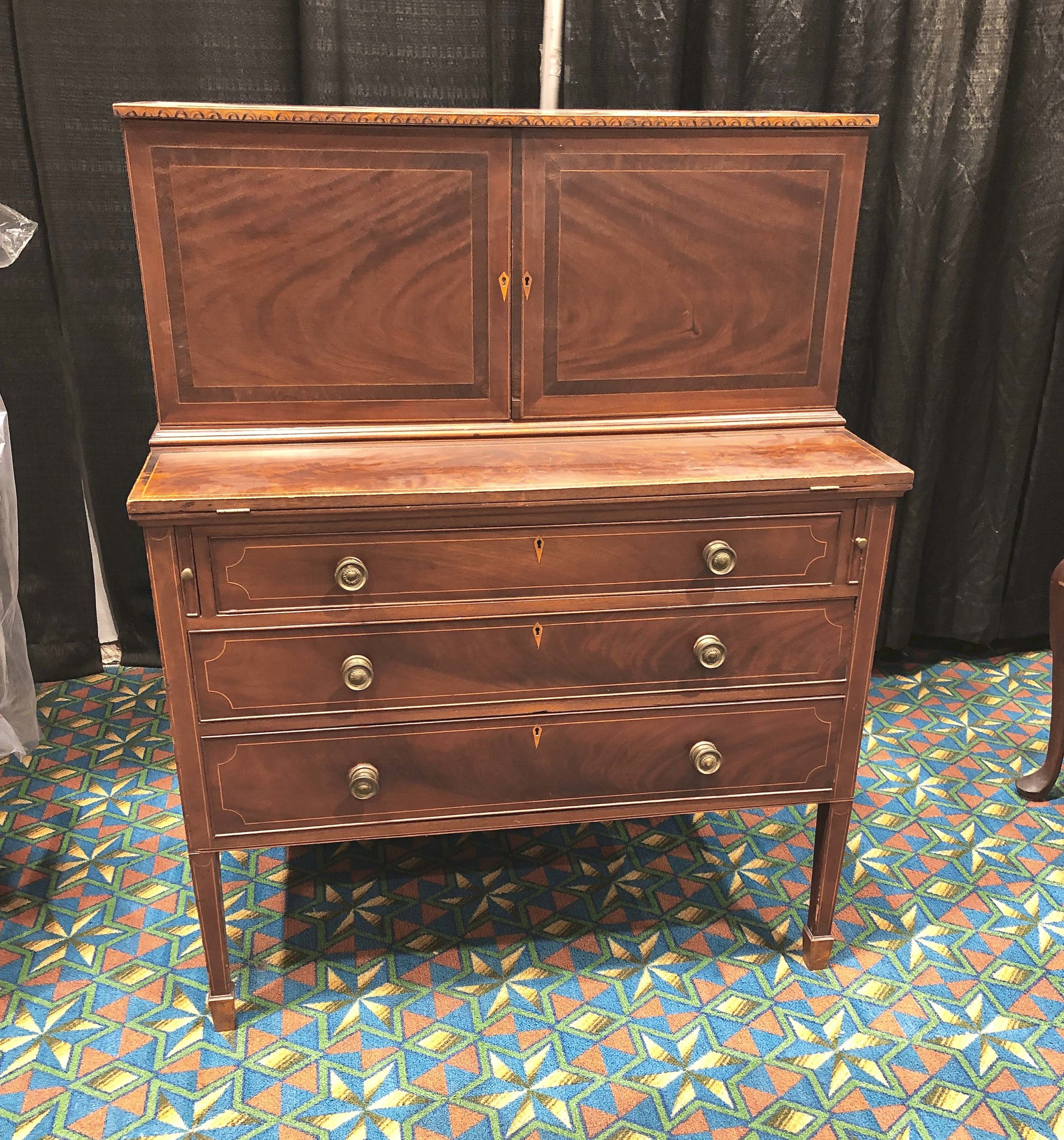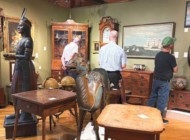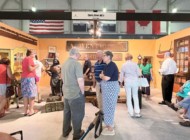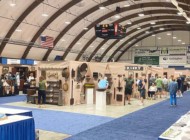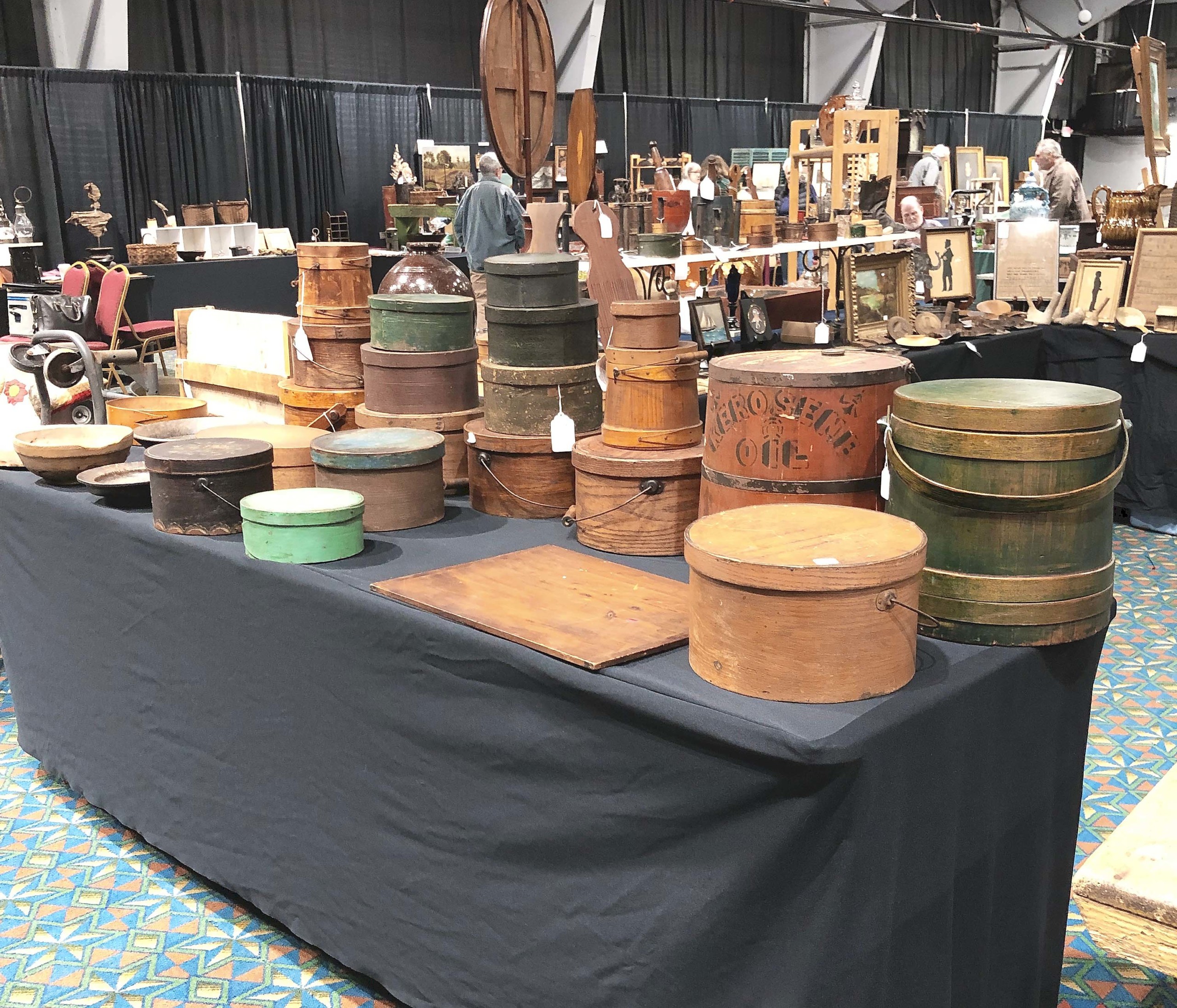
There were pantry boxes and firkins in several booths. But none of the other displays compared to this one. Brett Cabral, Salem, N.H., had about 20, at varying prices, with the large blue, swing-handled example priced $175.
Review & Photos by Rick Russack
BOXBOROUGH, MASS. — Prior to – and during – the initial hours of Rachel and Josh Gurley’s October 22 show in Boxborough, two words heard over and over again were “great stuff.”The Gurleys conducted the first of their four Boxborough shows this season — three more will follow. There were 40 exhibitors, and as is generally true of Gurley shows, Americana reigned supreme. But mid-Twentieth Century items are appearing more and more among the Eighteenth Century furniture, hearth accessories, silver and Delft, along with burl bowls, cloth dolls, decoys, Continental porcelains, painted woodenware, folk art, toys, plenty of paintings and some of those unexpected items, such as a brand-new pair of 1960s men’s shoes, that make going to shows the fun that it is. And since we’re into the holiday season, there were also Christmas and Halloween items in several booths. This is a well-established show, having first begun decades ago under the management of Nan Gurley, Rachel and Josh’s mother.
There were several pieces of Eighteenth and early Nineteenth Century furniture. One of the first pieces you would have seen would have been an old-red New Hampshire Chippendale tall chest in the booth of Jim LeFurgey and Judy Waner, East Winthrop, Maine. It had its original brass, they believed the finish to be original, and the price was $1,450. David and Jane Thompson, South Dennis, Mass., had an unusual blanket chest in well-worn red and blue paint. It was Norwegian, dated 1845 and had large hand-wrought hinges of a style not used in the United States and a comparable handmade lock and key. It was initialed, presumably with the initials of its owner. Jason Hietala, Lancaster, Mass., had several early pieces. One in particular he described in some detail. It was a circa 1790 Hepplewhite ladies’ writing desk that he said had been made by John Seymour, one of Boston’s premier cabinetmakers. It was mahogany, inlaid and banded with satinwood, including the spade feet and she-oak, a wood native to Australia and the western Pacific. The secondary wood used for the drawers was also mahogany, which he said, according to The Furniture Masterworks of John & Thomas Seymour by Robert D. Mussey Jr, was indicative of works made by John Seymour. It was priced $4,500. Formal and country furniture was in several other booths.
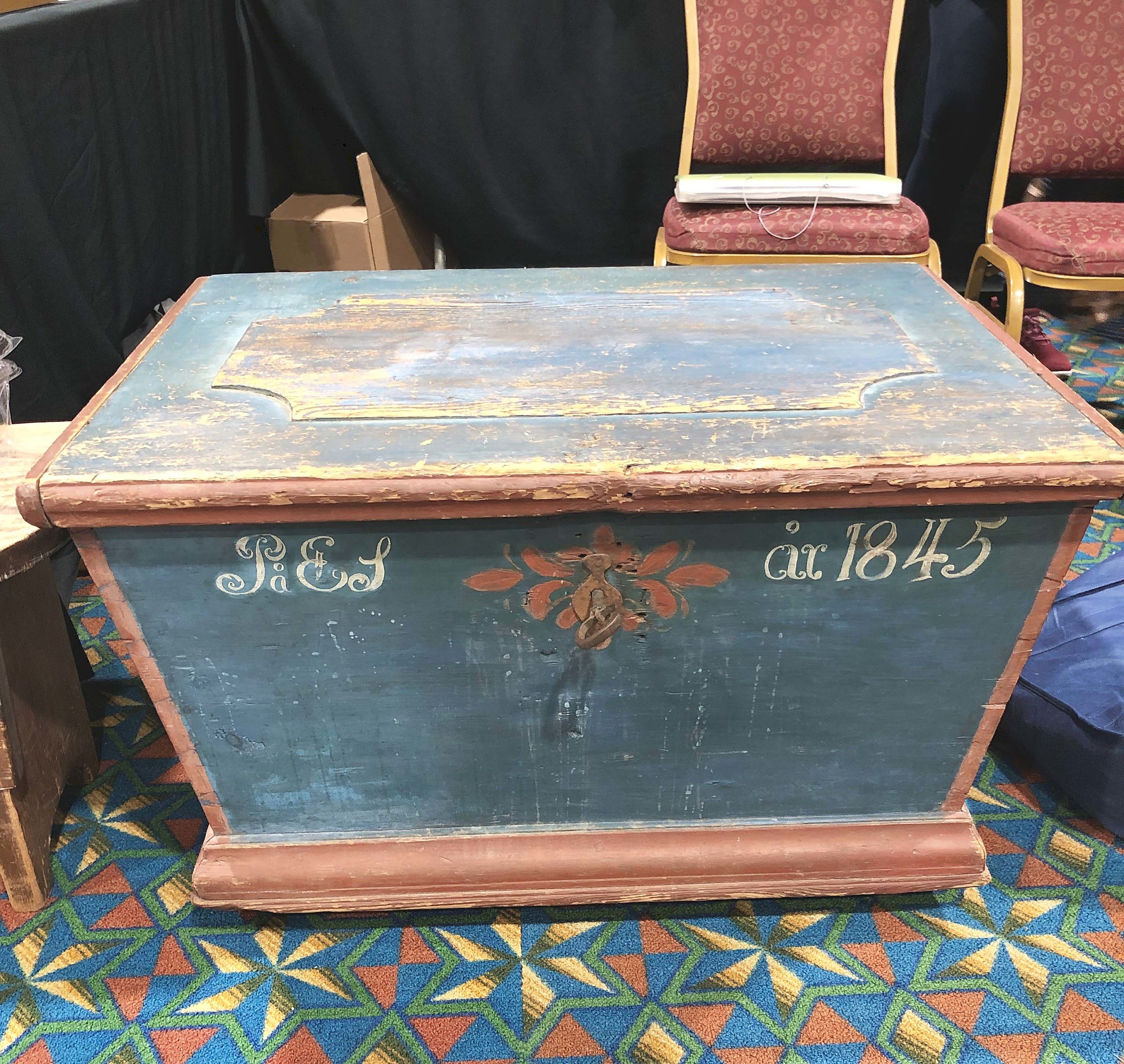
The chest was Norwegian, had unusual hinges and an unusual locking mechanism. It was dated 1845. It belonged to David and Jane Thompson, South Dennis, Mass., and it sold quickly.
Once it was a trade sign; now it’s folk art. Tommy Thompson, Chichester, N.H., had a flat, well-weathered pig, most of which had been fashioned from a single board. It had legs added and a curled iron tail. There was illegible, faint lettering and for $795 you could have taken it home. Elaine Fleming had an early, primitive portrait of a stylish young man on a cut-out piece of board. She thought it was a fragment of a larger work. It was by an unknown artist and she was asking $445. She also had a dressed cloth doll with a painted face. Stephen-Douglas Antiques, Rockingham, Vt., also had a good doll. Theirs was a male African American with stuffed facial details and a cloth hat. Also in their booth was a carved wooden rocking horse, more folk art than child’s toy. It was priced $675. Certainly considered folk art was a large carved and painted totem pole that Greg Hamilton, Stone Block Antiques, Vergennes, Vt., had brought. It was more than 6 feet tall, and it sold quickly.
Collectors of redware and stoneware, as well as early glass, would have had plenty to look at. Brian Cullity, Sagamore, Mass., had three Nineteenth Century redware plates, one of which, made in New Jersey, had slip decoration spelling out the word “Handy.” The price was $750. Charlie Guinipero, Pantry Box Antiques, Stafford Springs, Conn., had a small group of stoneware, with a Smith and Day ovoid jug from Norwalk, Conn., priced $395. Both Brian Cullity and Dennis Raleigh, Searsport, Maine, had early black glass bottles. Raleigh had a large, late Eighteenth Century or early Nineteenth Century oversized black gin bottle priced $850 and an “onion” bottle from the same era, priced $1,150.
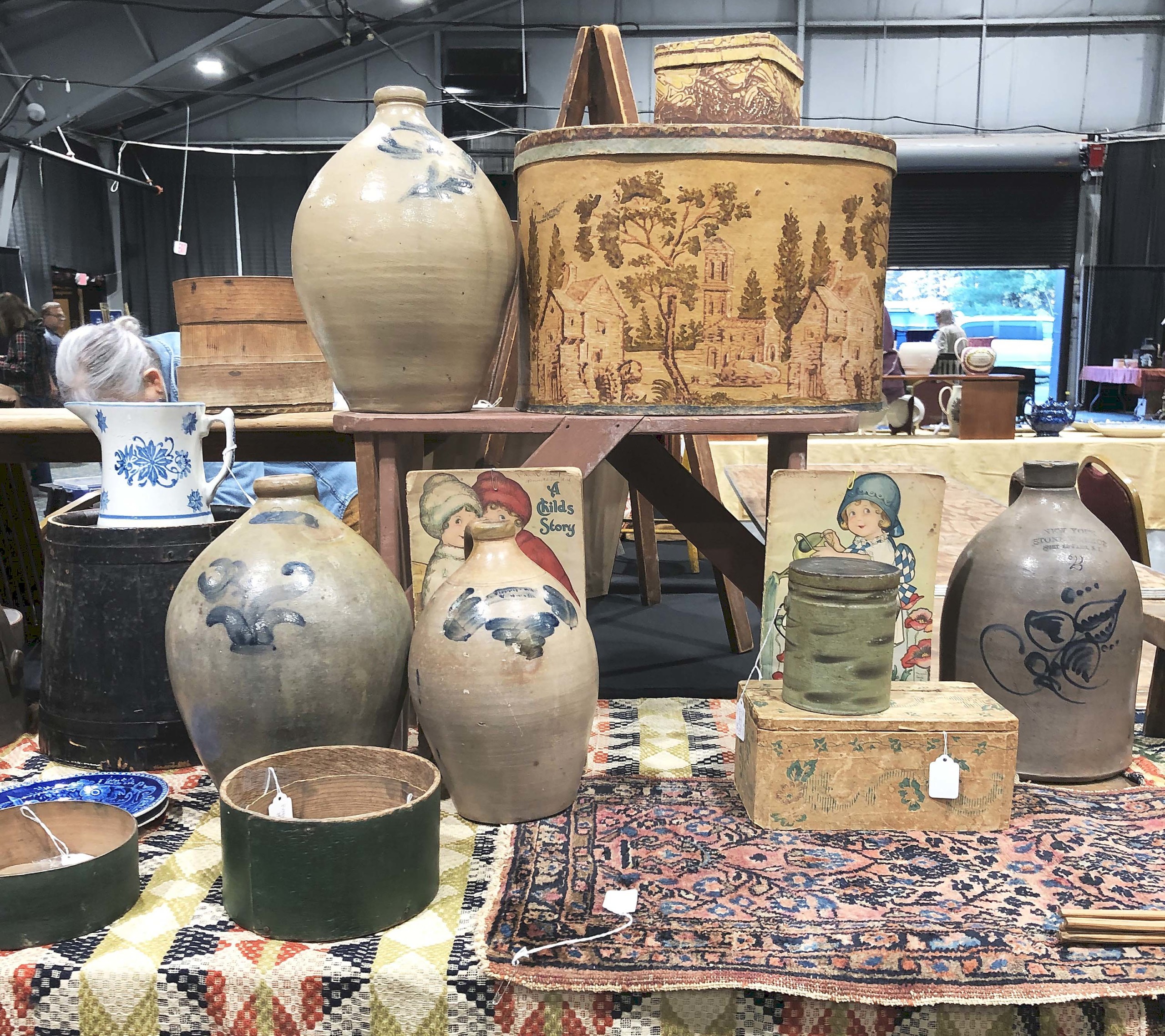
In addition to several pieces of stoneware, Charlie Guinipero, Pantry Box Antiques, Stafford Springs, Conn., had a large wall-paper hat box. The scene was of castles in Spain, it was 17 inches long and priced $895.
We mentioned that shoppers would have come across unexpected things. The first of these was a brand-new, unused pair of size 11D alligator Florsheim shoes, still in the original box. Belonging to Ken and Robin Pike, New Hampshire dealers who now only do shows, they were tagged as circa 1960 and the price was $185. Pat Reese and John Rice, Portsmouth, N.H., had one of those things that isn’t easy to describe. It might have been a sculpture created from two pieces of driftwood, mounted together as a sculpture. They weren’t asking much money for it, $85, and it’s safe to say you won’t find another. If you needed wooden hooks to be used as coat hangers or something else, Susan Wirth, Stafford Springs, Conn., had a large pile of them priced under $10 each. Bruce Emond, Village Braider, Plymouth, Mass., often has things you haven’t see before. This time he had a large weathered tree stump that would have made a one-of-a-kind side table or coffee table. He said it came from Martha’s Vineyard and it was priced $450.
Perhaps it was appropriate for this show, considering who was running it, that Charles Guinipero of Pantry Box Antiques, brought a group of Gurley candles dressed as Pilgrims, ready for Thanksgiving. These candles, now collectible, were made in the late Twentieth Century and he priced them $10 each, well below the prices asked by dealers on the internet. Another of the unexpected things was a large block of bee’s wax in the booth of Brett Cabral, Salem, N.H. He said that bee’s wax was stored that way at harvest, in wooden frames as his was, until the owner decided to melt some for candles or whatever other purpose. It came from a farm in Tewksbury, Mass. The price was $165.
Perhaps not totally unexpected were the early maps of the West that David and Jane Thompson had. One was a large map of Oregon and upper California from the Fremont survey of 1848, which was priced $1,500. John C. Fremont, who earned the nickname “Pathfinder,” led two surveys exploring the Far West. One of the objects of these exploring expeditions into uncharted areas added to America by the Louisiana Purchase was to bring back east botanical and other specimens. Fremont’s journal recounts that the mule carrying 1,400 plant specimens fell off a cliff when crossing the Sierra Nevada mountains, killing itself and destroying the specimens. The second map was earlier-1841. It, too, was of the Oregon territory from the Wilkes survey, which had been authorized by Congress in 1836.
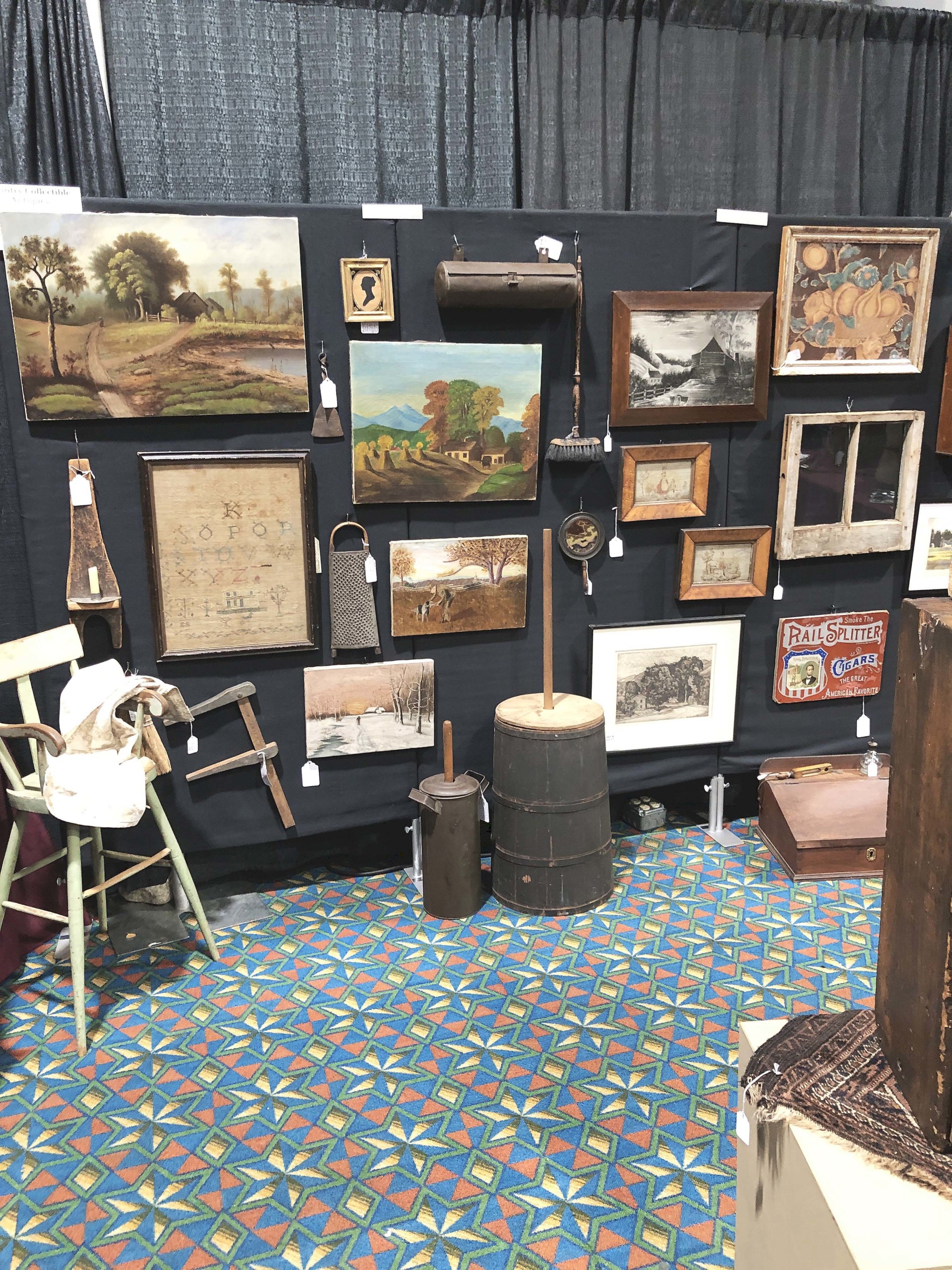
MG Art and Country Collectible Antiques shared a booth. They included woodenware and several paintings hanging on the rear wall of the booth.
After the show, Rachel and Josh Gurley agreed, “We love this show and we’re super happy to be back for another season. The quality was just outrageous, and the retail crowd was strong. Speaking for ourselves, most of our sales were to the retail buyers. One thing that has changed since the pandemic is that there aren’t the long lines waiting for the opening that we’re all used to seeing. Certainly, some folks are on line for the opening, with many arriving later, and then the traffic is steady all day. And many really take their time shopping. Different, but it works for everyone.” Commenting on their upcoming live auction, they said, “The first auction we’ll be conducting will be November 16 at Dover Elks Lodge. We’re selling the Fitts collection — tons of country store stuff, advertising and Americana.”
For additional information, www.gurleyantiqueshows.com or 207-396-4255.

